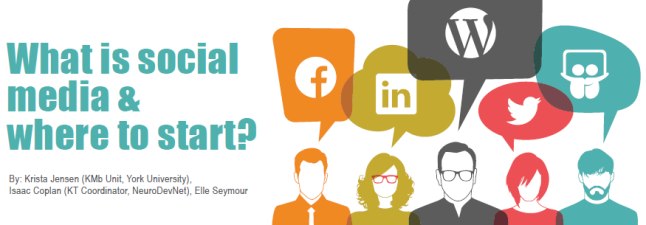This blog post was written by Anneliese Poetz, KT Manager for KBHN. It was originally published as a guest post on the ResearchImpact blog (Source: The “Guide of Guides” Series for Knowledge Translation) it is reposted here with permission.
Kids Brain Health Network (formerly NeuroDevNet) is a Network of Centres of Excellence funded by the Federal government of Canada. There are three discovery programs focused on the early diagnosis and treatment of: Fetal Alcohol Spectrum Disorder, Autism Spectrum Disorder, and Cerebral Palsy. Three Cores serve the researchers and trainees within the Network as well as the other Cores: Neuroethics, Neuroinformatics, and Knowledge Translation (KT). The KT Core is hosted by York University’s award winning Knowledge Mobilization (KMb) Unit and provides 7 services within the Network:
1- Knowledge Brokering
2- Support for KT Events
3- Support for KT Products
4- KT Capacity Building
5- Evaluating KT
6- Support KT Planning
7- Stakeholder Engagement
A couple of years ago, one of our researchers asked us for guidance for using social media for KT. We realized while searching for what was ‘already out there’ that there are a lot of guides for social media, but not all of them are targeted towards use by researchers. In collaboration with York University’s KMb Unit, we produced our first “Guide of Guides” that is a compilation of carefully selected and vetted guides for social media that are relevant. The “Guide of Guides” format resembles an annotated bibliography, where the reference information is provided for each guide along with a summary paragraph about the tool, how it can be used and why you may wish to use it. The “Social Media Guide of Guides” became the start of a series. This post serves as a “guide” to the “Guide of Guides” series.
Soon after, we produced the “KT Planning Guide of Guides”.
We were doing a search for existing KT planning guides because another project we were working on was to provide KT planning support for 4 key projects within the Network and we wanted to see if there was a tool out there that we could use. What we ended up doing was creating our own, that was specific to our own needs (the Hybrid KT Planning and Project Management tool). However, we had conducted an exhaustive search of existing KT Planning tools so we reviewed and vetted them for quality and relevance, and created a similar “Guide of Guides” for KT Planning.
We received several requests from researchers for support and resources for creating infographics. After searching for existing guides, we realized that surprisingly there weren’t any guides for researchers about infographics, only blog posts. So, we vetted the blog posts, searched the literature and wrote a comprehensive evidence-based guide, followed by an annotated list of what we deemed were the best blog posts on infographics. Some blog posts pointed to examples of infographics, while others explained step by step how to create an infographic and what tools were available (usually free, online) for creating your own. While the content wasn’t really a “Guide of Guides” per se, we titled this product the “Infographic Guide of Guides”. We were fortunate to have one project team pilot test a draft of this guide and provide feedback before it was finalized and posted. This is the first guide that included an appendix with form-fillable fields to help research teams work through the process of creating an infographic.
Finally, we produced a “Stakeholder Engagement Guide of Guides”. There are many guides for doing stakeholder engagement, and it is becoming more important for KBHN to do stakeholder engagement in a more formalized way. After searching, reviewing, and vetting guides available online, we created a similarly formatted “Guide of Guides” for stakeholder engagement that also included a form-fillable appendix to help facilitate planning. Since there are many different reasons (goals/objectives) for engaging with stakeholders and many different formats for doing so, we created a summary table at the beginning of the guide that separates the types of engagement into three tables: mostly sharing information with stakeholders, sharing and listening, and mostly listening. The list of specific formats within each category was visually coded so that the user can easily find the corresponding guide for detailed information.
The KT Core may produce one more “Guide of Guides” on evaluation methods for KT.

 This week, a new
This week, a new  Organizations have recognized the power of social media and try to create content that will be shared, and go ‘viral’, with the end result being uptake and implementation of their messages. There is a fine line between ‘gimmicky-ness’ that could reduce credibility and cause people to ignore
Organizations have recognized the power of social media and try to create content that will be shared, and go ‘viral’, with the end result being uptake and implementation of their messages. There is a fine line between ‘gimmicky-ness’ that could reduce credibility and cause people to ignore  it, and something that can go viral while causing effective uptake of evidence-based messages. The
it, and something that can go viral while causing effective uptake of evidence-based messages. The 

 One thing that I should also mention is the power of
One thing that I should also mention is the power of 







